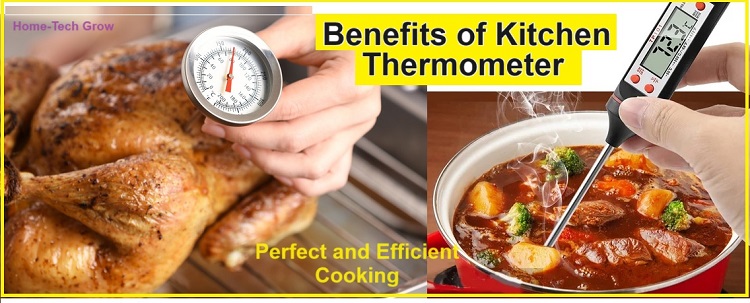Scope of kitchen Thermometer in Cooking
- a kitchen thermometer is a versatile tool that contributes significantly to ensuring food safety, perfect cooking outcomes, and consistent results across various culinary endeavors, ranging from everyday cooking to intricate culinary techniques.
- It’s an indispensable device that helps home cooks and professional chefs achieve precise and safe cooking temperatures, making their culinary creations both delicious and safe to consume
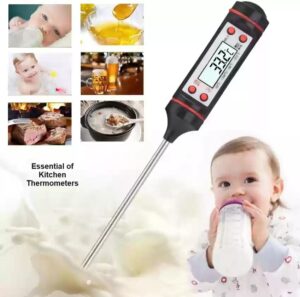
Essentials kitchen thermometer
- A kitchen thermometer has a broad and significant scope in cooking and food preparation. It’s an essential tool used to measure the temperature of food, ensuring it’s safe to eat and cooked to the right level. Here’s the scope and importance of a kitchen thermometer:
- Food Safety:
- Ensures food safety by accurately measuring the internal temperature of meat, poultry, fish, and other cooked dishes.
- It helps prevent foodborne illnesses by verifying that food has been cooked to the recommended safe temperature.
- Precision Cooking:
- Helps achieve precise cooking temperatures for different types of dishes
- Ensure cooking of foods like meats are cooked to the desired level (rare, medium, well-done) without overcooking.

How to Use a Meat Thermometer the Right Way
- Baking and Pastry Making:
- Essential for baking, ensuring that bread, pastries, and desserts reach the right internal temperature, which is crucial for proper texture, rise, and doneness.
- Candy Making and Sugar Work:
- Crucial for candy making and sugar work where reaching specific temperatures is necessary for candies, syrups, and caramel to achieve the right consistency.
- Yogurt and Cheese Making:
- Useful for ensuring milk reaches the right temperature for yogurt and cheese-making processes, where precise temperatures are crucial for fermentation and curdling.
- Brewing and Beverage Making:
- Valuable in brewing beer, making wine, or preparing beverages where temperature control is vital for fermentation or steeping processes.
- Grilling and Barbecuing:
- Allows for accurate monitoring of the internal temperature of grilled or barbecued meats, ensuring they’re cooked to perfection without being undercooked or overdone.
- Smoking Meats:
- Critical in smoking meats where the temperature inside the smoker needs to be controlled and maintained for the right length of time to cook and infuse flavors properly.
- Deep Frying:
- Helps in maintaining the right oil temperature for deep frying, ensuring that foods are cooked evenly and don’t absorb excess oil.
- Leftovers and Reheating:
- Helps ensure that leftover foods are reheated to a safe temperature to prevent bacterial growth and ensure they’re safe for consumption.
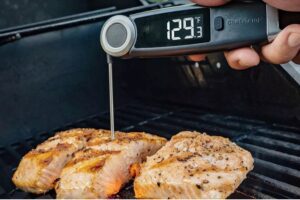
Advantage of kitchen thermometer
- Kitchen thermometers offer several advantages that can significantly improve your cooking and baking experiences.
- Here are some of the key benefits of using a kitchen thermometer:
- Precision Cooking: Kitchen thermometers provide accurate temperature readings, allowing you to cook food to the perfect level of doneness. Whether you’re grilling a steak, roasting a turkey, or baking bread, a thermometer helps you achieve consistent and precise results.
- Food Safety: Ensuring that food reaches the recommended safe internal temperature is crucial for food safety. A kitchen thermometer helps you avoid undercooking, which can lead to foodborne illnesses, and overcooking, which can result in dry and unappetizing dishes.
- Consistency:
- With a thermometer, you can replicate your favorite recipes with consistent results every time you cook.
- This is especially important for dishes like steaks, where a few degrees can make a big difference in doneness.
- Eliminates Guesswork:
- Using a thermometer eliminates the need for guesswork when determining if a dish is done.
- You no longer have to rely on visual cues or arbitrary cooking times; the thermometer provides an objective measure of doneness.
- Versatility:
- Kitchen thermometers come in various types, such as instant-read, probe, and infrared thermometers, each suited for specific tasks.
- This versatility allows you to use the right tool for the job, whether you’re making candy, roasting meat, or baking delicate pastries.
- Time-Saving:
- By accurately monitoring cooking temperatures, you can reduce the likelihood of overcooking, saving time and energy.
- You can confidently remove food from heat once it reaches the desired temperature, eliminating the need for lengthy cooking times.
- Enhances Flavor:
- Properly cooked food retains its flavor, moisture, and tenderness.
- A thermometer ensures that you don’t overcook or dry out your dishes, leading to more delicious and enjoyable meals.
- Reduces Food Waste:
- With precise temperature control, you’re less likely to overcook or burn your food, reducing food waste and saving money on ingredients.
- Helps in Multitasking:
- For complex recipes that involve multiple components or dishes, using a thermometer can help you manage your time effectively.
- You can monitor the temperature of different items simultaneously, ensuring that everything is cooked perfectly.
- Improves Confidence:
- With a kitchen thermometer, you can approach cooking with confidence, knowing that your dishes will turn out as expected.
- It’s a valuable tool for both novice and experienced cooks.
- Wide Range of Applications:
- Kitchen thermometers can be used for various cooking methods, including grilling, baking, frying, sous vide cooking, candy making, and more.
- They are versatile tools that adapt to different culinary needs.
- Health Consciousness:
-
- For those concerned about health and nutrition, using a thermometer ensures that meat and poultry are cooked to safe temperatures, reducing the risk of foodborne illnesses.
- Safe and Hygienic:
- Kitchen thermometers help avoid unnecessary poking or cutting of food to check its doneness, which can lead to loss of juices and flavor.
- This is especially important when preparing expensive cuts of meat.
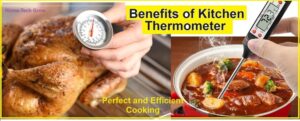
How to Use the Kitchen Thermometer?
Using a kitchen thermometer correctly is crucial for accurate temperature readings and ensuring food safety. Here’s a guide on how to use a kitchen thermometer effectively:
- Select the Right Thermometer:
- Different types of kitchen thermometers are available, such as instant-read, probe, and infrared thermometers. Choose the appropriate type based on the food you’re preparing and the accuracy required.
- Calibrate the Thermometer (if possible):
- Some thermometers allow calibration to ensure accuracy. Follow the manufacturer’s instructions for calibration.
- Read the Manufacturer’s Instructions:
- Each thermometer has specific usage guidelines provided by the manufacturer. Familiarize yourself with these instructions before use.
- Clean and Sanitize the Thermometer:
- Before and after each use, ensure the thermometer is clean and sanitized to prevent cross-contamination. Use warm, soapy water or an appropriate disinfectant.
- Insert the Thermometer Correctly:
- For probe thermometers, insert the probe into the thickest part of the food, away from bones or fat, ensuring it doesn’t touch the pan or tray. For thin cuts or patties, insert the probe sideways to measure the temperature accurately.
- Wait for Stable Reading:
- Allow the thermometer a few seconds to stabilize and display an accurate reading. Some thermometers may take a little time to adjust to the actual temperature.
- Use Different Thermometers for Different Foods:
- Consider using separate thermometers for different food types, especially when dealing with raw meats and ready-to-eat foods to prevent cross-contamination.
- Take Multiple Readings:
- For larger cuts of meat or dishes, take readings in multiple spots to ensure even cooking throughout the food item.
- Clean After Use:
- After using the thermometer, clean and sanitize it again, and store it properly. Ensure it’s stored safely to prevent damage and maintain accuracy.
- Understanding Safe Cooking Temperatures:
- Familiarize yourself with recommended safe cooking temperatures for different types of food. For instance, the USDA provides guidelines for safe minimum internal temperatures for various foods.
- Consider the Resting Period:
- For some dishes, especially meats, it’s essential to let the food rest after cooking. During this period, the internal temperature may continue to rise. Account for this when using a thermometer.
- Use Visual Cues with Temperature:
- While the thermometer provides an accurate temperature reading, it’s also helpful to look for visual cues like color and texture to ensure the food is cooked to your preference.
- By following these steps and paying attention to the guidelines provided by the thermometer’s manufacturer, you can use a kitchen thermometer effectively and ensure that your food is cooked to the right temperature, promoting both taste and safety in your culinary creations.
Temperature range for cooked foods
- The safe internal temperature for cooked foods varies depending on the type of food being prepared.
- It’s important to note that the following temperatures are recommended by food safety organizations, such as the USDA (United States Department of Agriculture), to ensure that harmful bacteria, such as Salmonella, E. coli, and Listeria, are destroyed.
- Using a food thermometer is the most reliable way to ensure that foods have reached the recommended safe internal temperatures for consumption.
- Here are the recommended safe cooking temperatures for various types of food:
Beef, Pork, Lamb, and Veal:
- Steaks, roasts, and chops: 145°F (63°C) with a three-minute rest time.
- Ground meats: 160°F (71°C).
- Ground poultry: 165°F (74°C).
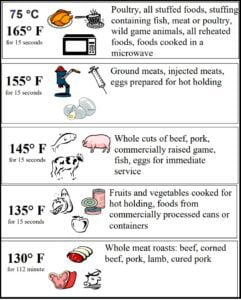
Poultry:
- Whole poultry (chicken, turkey): 165°F (74°C).
- Poultry breasts: 165°F (74°C).
- Poultry thighs, wings: 165°F (74°C).
Seafood:
- Fish: 145°F (63°C) until the flesh is opaque and easily flakes with a fork.
- Shrimp, lobster, and crabs: Cook until they turn red and the flesh is pearly opaque.
- Scallops: Cook until they turn milky white and firm.
Ground Meats:
- Ground beef, pork, lamb, and veal: 160°F (71°C).
- Ground poultry: 165°F (74°C).
Egg Dishes:
-
- Dishes containing eggs, such as casseroles: 160°F (71°C).
Leftovers and Casseroles:
-
- Reheat leftovers and casseroles to 165°F (74°C).

Vegetables
- A food thermometer can be used to check food is cooked thoroughly, food should be 75°C or above in the thickest part.
- Some foods change colour when they are cooked so you can check this too.
- Always check your food is steaming hot in the middle. Make sure frozen vegetables are cooked before you eat them.
Best kitchen thermometer
- The best kitchen thermometer for you depends on your specific needs and preferences.
- When selecting a kitchen thermometer, consider factors such as your cooking style, the types of dishes you frequently prepare, and your budget.
- Additionally, look for reliable brands known for accuracy and durability. ThermoWorks, Lavatools, Weber, and Etekcity are well-regarded brands in the industry.
- There are various types of kitchen thermometers available, each with its own advantages.
- Here are some popular types of kitchen thermometers, along with recommendations for each category:
- Instant-Read Thermometer:
- Ideal for quickly checking the temperature of food items.
- Recommended: Thermapen Mk4 or Lavatools Javelin Pro Duo.
- Digital Probe Thermometer:
- Suitable for roasts, poultry, and large cuts of meat.
- Recommended: ThermoWorks ChefAlarm or ThermoPro TP20.
- Infrared Thermometer:
- Great for measuring surface temperatures and for grilling.
- Recommended: Etekcity Lasergrip 774 or Fluke 62 Max.
- Oven Thermometer:
- Ensures your oven is at the correct temperature.
- Recommended: OXO Good Grips Oven Thermometer.
- Candy Thermometer:
- Specifically designed for making candies and syrups.
- Recommended: CDN DTC450 Digital Candy/Deep Fry/Pre-Programmed & Programmable Thermometer.
- Leave-In Thermometer:
- Designed for monitoring the temperature while cooking without opening the oven.
- Recommended: ThermoWorks Signals or MEATER+.
- Bluetooth or Wi-Fi Thermometer:
- Allows remote monitoring via smartphone apps.
- Recommended: Weber iGrill 2 or ThermoWorks Smoke X2.
- Thermocouple Thermometer:
- Offers rapid and highly accurate temperature readings.
- Recommended: ThermoWorks Thermapen One or Thermoworks Thermapen IR.
- Non-Contact Thermometer (Infrared Gun):
- Perfect for checking the surface temperature of grills, pans, and stovetops.
- Recommended: Etekcity Lasergrip 1080.
Conclusion
- a kitchen thermometer is a valuable and versatile tool that can enhance your cooking skills, improve the quality and safety of your meals, and provide consistent, delectable results.
- Whether you’re a home cook or a professional chef, having a reliable kitchen thermometer in your culinary toolkit is a wise investment that will elevate your cooking to new heights.
References
- U.S.A Food Inspection, How Temperatures Affect food
- Virginia Agriculture, Hop Tips for Temp
